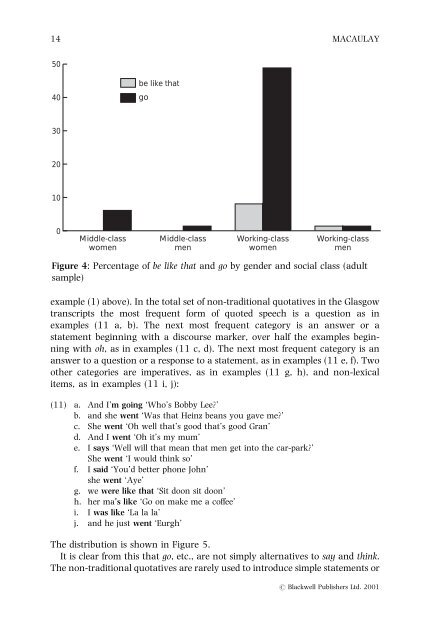You're like `why not?' The quotative expressions of Glasgow ...
You're like `why not?' The quotative expressions of Glasgow ...
You're like `why not?' The quotative expressions of Glasgow ...
You also want an ePaper? Increase the reach of your titles
YUMPU automatically turns print PDFs into web optimized ePapers that Google loves.
14<br />
50<br />
40<br />
30<br />
20<br />
10<br />
0<br />
Middle-class<br />
women<br />
be <strong>like</strong> that<br />
go<br />
Middle-class<br />
men<br />
Working-class<br />
women<br />
example 1) above). In the total set <strong>of</strong> non-traditional <strong>quotative</strong>s in the <strong>Glasgow</strong><br />
transcripts the most frequent form <strong>of</strong> quoted speech is a question as in<br />
examples 11 a, b). <strong>The</strong> next most frequent category is an answer or a<br />
statement beginning with a discourse marker, over half the examples beginning<br />
with oh, as in examples 11 c, d). <strong>The</strong> next most frequent category is an<br />
answer to a question or a response to a statement, as in examples 11 e, f). Two<br />
other categories are imperatives, as in examples 11 g, h), and non-lexical<br />
items, as in examples 11 i, j):<br />
11) a. And I'm going `Who's Bobby Lee?'<br />
b. and she went `Was that Heinz beans you gave me?'<br />
c. She went `Oh well that's good that's good Gran'<br />
d. And I went `Oh it's my mum'<br />
e. I says `Well will that mean that men get into the car-park?'<br />
She went `I would think so'<br />
f. I said `You'd better phone John'<br />
she went `Aye'<br />
g. we were <strong>like</strong> that `Sit doon sit doon'<br />
h. her ma's <strong>like</strong> `Go on make me a co€ee'<br />
i. I was <strong>like</strong> `La la la'<br />
j. and he just went `Eurgh'<br />
MACAULAY<br />
Working-class<br />
men<br />
Figure 4: Percentage <strong>of</strong> be <strong>like</strong> that and go by gender and social class adult<br />
sample)<br />
<strong>The</strong> distribution is shown in Figure 5.<br />
It is clear from this that go, etc., are <strong>not</strong> simply alternatives to say and think.<br />
<strong>The</strong> non-traditional <strong>quotative</strong>s are rarely used to introduce simple statements or<br />
# Blackwell Publishers Ltd. 2001
















